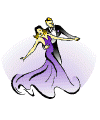|
|
Heel Turns
by Curt & Tammy Worlock
In the Imperial Society of Teachers of Dancing book called The Ballroom
Technique, a heel turn is described as "A turn that is first commenced
on the ball of the stepping foot and then continued on the heel, the
closing foot being kept parallel throughout. The weight is transferred
on to the foot that has closed as the turn is completed." Having stated
that, the big question that remains is: How do we accomplish this? It
is one of the most difficult techniques in all of dancing and one that
the lady must do much more often than the man, especially in foxtrot.
First we must understand that early rise from the man is what
ultimately leads a heel turn. His initial step in the measure is
shortened to a degree by using slightly less lowering and driving
action to assist the lady in quickly bringing her feet together with
straight legs. In effect, we could say that the man's steps are more
compact when leading a heel turn figure as compared to one that does
not have a heel turn, because of the technique involved in creating a
good heel turn. Some of the more common misunderstandings about a heel
turn that we must learn are what we are going to call our 5 rules of
heel turns. If we can only handle or understand one at a time, so be
it, as long as we continue to put in the practice and eventually master
all five to make ourselves better dancers.
1. There is no such thing as a
HEELS turn.
A heel turn is done only on the foot that he or she steps back on when
commencing a figure. Left turning figures should be executed on the
right heel and right turning figures will be done on the left heel.
2. We do not close our feet to change weight immediately.
If we did, we would break rule #1 and dance a heel turn on the second
step or the wrong foot. Also, taking weight right away hinders your
partner's ability to swing through you, as it makes you a brick wall
rather than a revolving door, which is what you want to be.
3. A toe spin can truly never take the place of a good heel turn.
As stated in rule #1, the turn is made on the heel of the initial back
step followed quickly by rise to the toes to change weight as the turn
is finished. Most of us have anywhere from 4 to 6 inches between the
heel and ball of our foot. Some more, some less, but this distance can
cause partner separation. We could go as far as saying that there is a
fraction of progression to a heel turn. Bottom Line: Get rid of toe
turns if you are able.
4. Leaning back will NOT help a heel turn.
If anything, keep forward poise and hips up to partner. In fact,
leaning back will only hinder the heel turn and cause the toes to have
that "point to the ceiling look," and of course will only make yourself
unbalanced as well as pull your partner forward. The balls of the feet
should skim the floor as you do your heel turn while the feet turn as
one as if you had Velcro on your insteps.
5. The woman (or man) does not do the heel turn by her- or himself.
Heel turns should be caused by your partner swinging through you,
literally turning your hips with his or her own. This will enable you
to maintain that perfect contact as you trade places with your partner
and avoid the "belly rub" or becoming disconnected from partner.
Two important points: (a) DO NOT TURN THE FOOT ON STEP ONE! and (b)
Whoever is dancing forward, or the person who is not actually doing the
heel turn, should think: TWO FORWARD STEPS when doing any heel turn
figure.
If we can learn these 5 rules of heel turns, we will be in good shape
to comprehend the techniques involved in accomplishing these rules, and
hopefully we will all make it our goal as we strive to become better
dancers through education. In our humble opinion, you have all found
the best form of dancing on the planet. You will only enjoy it more and
more as you learn and become more accomplished dancers. Just keep in
mind, results are not overnight and "nothing good comes easy". At the
same time, we cannot say we are too old to learn anymore, or that we
have done it this way for so long, we cannot change it. Don't quit!
Remember, we don't quit dancing because we grow old, but we grow old
because we quit dancing. Keep smiling and have fun!
From clinic notes prepared for
the URDC convention, July 2002, and reprinted in the DRDC newsletter,
November 2025.

|
